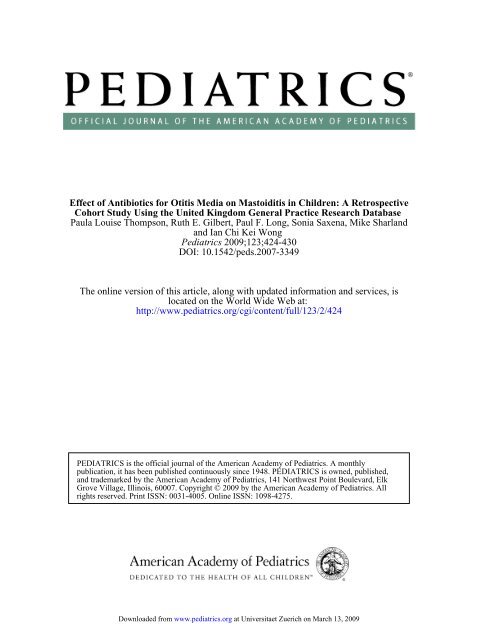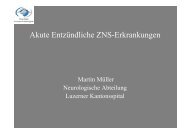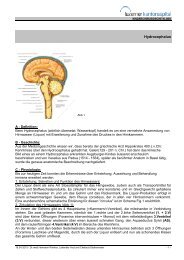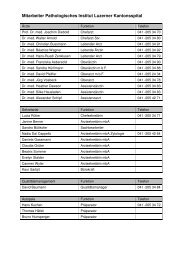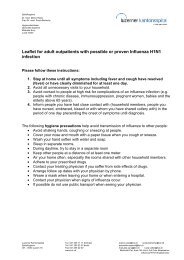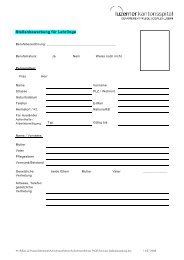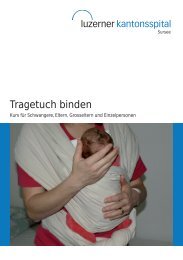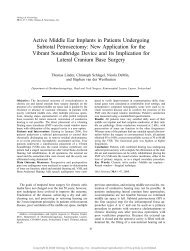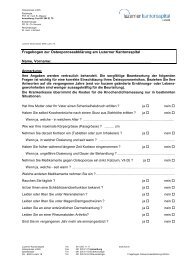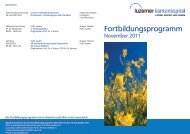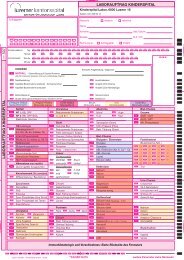Effect of Antibiotics for Otitis Media on Mastoiditis in Children
Effect of Antibiotics for Otitis Media on Mastoiditis in Children
Effect of Antibiotics for Otitis Media on Mastoiditis in Children
Create successful ePaper yourself
Turn your PDF publications into a flip-book with our unique Google optimized e-Paper software.
<str<strong>on</strong>g>Effect</str<strong>on</strong>g> <str<strong>on</strong>g>of</str<strong>on</strong>g> <str<strong>on</strong>g>Antibiotics</str<strong>on</strong>g> <str<strong>on</strong>g>for</str<strong>on</strong>g> <str<strong>on</strong>g>Otitis</str<strong>on</strong>g> <str<strong>on</strong>g>Media</str<strong>on</strong>g> <strong>on</strong> <strong>Mastoiditis</strong> <strong>in</strong> <strong>Children</strong>: A Retrospective<br />
Cohort Study Us<strong>in</strong>g the United K<strong>in</strong>gdom General Practice Research Database<br />
Paula Louise Thomps<strong>on</strong>, Ruth E. Gilbert, Paul F. L<strong>on</strong>g, S<strong>on</strong>ia Saxena, Mike Sharland<br />
and Ian Chi Kei W<strong>on</strong>g<br />
Pediatrics 2009;123;424-430<br />
DOI: 10.1542/peds.2007-3349<br />
The <strong>on</strong>l<strong>in</strong>e versi<strong>on</strong> <str<strong>on</strong>g>of</str<strong>on</strong>g> this article, al<strong>on</strong>g with updated <strong>in</strong><str<strong>on</strong>g>for</str<strong>on</strong>g>mati<strong>on</strong> and services, is<br />
located <strong>on</strong> the World Wide Web at:<br />
http://www.pediatrics.org/cgi/c<strong>on</strong>tent/full/123/2/424<br />
PEDIATRICS is the <str<strong>on</strong>g>of</str<strong>on</strong>g>ficial journal <str<strong>on</strong>g>of</str<strong>on</strong>g> the American Academy <str<strong>on</strong>g>of</str<strong>on</strong>g> Pediatrics. A m<strong>on</strong>thly<br />
publicati<strong>on</strong>, it has been published c<strong>on</strong>t<strong>in</strong>uously s<strong>in</strong>ce 1948. PEDIATRICS is owned, published,<br />
and trademarked by the American Academy <str<strong>on</strong>g>of</str<strong>on</strong>g> Pediatrics, 141 Northwest Po<strong>in</strong>t Boulevard, Elk<br />
Grove Village, Ill<strong>in</strong>ois, 60007. Copyright © 2009 by the American Academy <str<strong>on</strong>g>of</str<strong>on</strong>g> Pediatrics. All<br />
rights reserved. Pr<strong>in</strong>t ISSN: 0031-4005. Onl<strong>in</strong>e ISSN: 1098-4275.<br />
Downloaded from<br />
www.pediatrics.org at Universitaet Zuerich <strong>on</strong> March 13, 2009
ARTICLE<br />
<str<strong>on</strong>g>Effect</str<strong>on</strong>g> <str<strong>on</strong>g>of</str<strong>on</strong>g> <str<strong>on</strong>g>Antibiotics</str<strong>on</strong>g> <str<strong>on</strong>g>for</str<strong>on</strong>g> <str<strong>on</strong>g>Otitis</str<strong>on</strong>g> <str<strong>on</strong>g>Media</str<strong>on</strong>g> <strong>on</strong> <strong>Mastoiditis</strong><br />
<strong>in</strong> <strong>Children</strong>: A Retrospective Cohort Study Us<strong>in</strong>g the<br />
United K<strong>in</strong>gdom General Practice Research Database<br />
Paula Louise Thomps<strong>on</strong>, BSc, MSc Epid a , Ruth E. Gilbert, MB ChB, MSc Epid, MD b , Paul F. L<strong>on</strong>g, BSc, MSc, PhD (Cantab) a,c ,<br />
S<strong>on</strong>ia Saxena, MBBS, MSc, MD, MRCGP d , Mike Sharland, FRCPCH, BSc, MD e , Ian Chi Kei W<strong>on</strong>g, BSc, MSc, PhD a<br />
a Centre <str<strong>on</strong>g>for</str<strong>on</strong>g> Paediatric Pharmacy Research and c Department <str<strong>on</strong>g>of</str<strong>on</strong>g> Pharmaceutics, School <str<strong>on</strong>g>of</str<strong>on</strong>g> Pharmacy, University <str<strong>on</strong>g>of</str<strong>on</strong>g> L<strong>on</strong>d<strong>on</strong>, L<strong>on</strong>d<strong>on</strong>, England; b Centre <str<strong>on</strong>g>for</str<strong>on</strong>g> Paediatric<br />
Epidemiology and Biostatistics, Institute <str<strong>on</strong>g>of</str<strong>on</strong>g> Child Health, L<strong>on</strong>d<strong>on</strong>, England; d Department <str<strong>on</strong>g>of</str<strong>on</strong>g> Primary Care and Social Medic<strong>in</strong>e, Imperial College, L<strong>on</strong>d<strong>on</strong>, England;<br />
e Paediatric Infectious Diseases Unit, St George’s Hospital, L<strong>on</strong>d<strong>on</strong>, England<br />
F<strong>in</strong>ancial Disclosure: Ms Thomps<strong>on</strong> and Drs Gilbert, Sharland, and W<strong>on</strong>g were members <str<strong>on</strong>g>of</str<strong>on</strong>g> the UK Department <str<strong>on</strong>g>of</str<strong>on</strong>g> Health’s Specialist Advisory Committee <strong>on</strong> Antimicrobial Resistance (SACAR), pediatrics<br />
subgroup. Drs L<strong>on</strong>g and Saxena have no f<strong>in</strong>ancial relati<strong>on</strong>ships relevant to this article to disclose.<br />
What’s Known <strong>on</strong> This Subject<br />
Ecological studies <str<strong>on</strong>g>of</str<strong>on</strong>g> rout<strong>in</strong>e health care databases have suggested that the reducti<strong>on</strong> <strong>in</strong><br />
antibiotic prescrib<strong>in</strong>g to children may be associated with an <strong>in</strong>crease <strong>in</strong> rare complicati<strong>on</strong>s<br />
<str<strong>on</strong>g>of</str<strong>on</strong>g> bacterial <strong>in</strong>fecti<strong>on</strong>, particularly mastoiditis after otitis media. Individual patientlevel<br />
analyses are now required.<br />
ABSTRACT<br />
What This Study Adds<br />
BACKGROUND. In<str<strong>on</strong>g>for</str<strong>on</strong>g>mati<strong>on</strong> is needed <strong>on</strong> whether mastoiditis has <strong>in</strong>creased <strong>in</strong> associati<strong>on</strong><br />
with the decl<strong>in</strong>e <strong>in</strong> antibiotics prescribed to children by primary care physicians <strong>in</strong><br />
the United K<strong>in</strong>gdom.<br />
OBJECTIVE. To determ<strong>in</strong>e time trends <strong>in</strong> mastoiditis <strong>in</strong>cidence, the frequency <str<strong>on</strong>g>of</str<strong>on</strong>g> antecedent<br />
otitis media, and the effect <str<strong>on</strong>g>of</str<strong>on</strong>g> antibiotics <str<strong>on</strong>g>for</str<strong>on</strong>g> otitis media <strong>on</strong> the risk <str<strong>on</strong>g>of</str<strong>on</strong>g><br />
mastoiditis <strong>in</strong> children.<br />
PATIENTS AND METHODS. We c<strong>on</strong>ducted a retrospective cohort study by us<strong>in</strong>g the UK<br />
General Practice Research Database. <strong>Children</strong> aged 3 m<strong>on</strong>ths to 15 years between<br />
1990 and 2006 were <strong>in</strong>cluded. Risk <str<strong>on</strong>g>of</str<strong>on</strong>g> mastoiditis with<strong>in</strong> 3 m<strong>on</strong>ths after otitis media<br />
diagnosis and the protective effect <str<strong>on</strong>g>of</str<strong>on</strong>g> antibiotics were determ<strong>in</strong>ed.<br />
RESULTS. There were 2 622 348 children with<strong>in</strong> the General Practice Research Database;<br />
854 had mastoiditis, <strong>on</strong>ly <strong>on</strong>e third <str<strong>on</strong>g>of</str<strong>on</strong>g> whom (35.7%) had antecedent otitis<br />
media. <strong>Mastoiditis</strong> <strong>in</strong>cidence rema<strong>in</strong>ed stable between 1990 and 2006 (�1.2 per<br />
10 000 child-years). Risk <str<strong>on</strong>g>of</str<strong>on</strong>g> mastoiditis, after otitis media, was 1.8 per 10 000<br />
episodes (139 <str<strong>on</strong>g>of</str<strong>on</strong>g> 792 623) after antibiotics compared with 3.8 per 10 000 (149 <str<strong>on</strong>g>of</str<strong>on</strong>g><br />
389 649) without antibiotics, and <strong>in</strong>creased with age. <str<strong>on</strong>g>Antibiotics</str<strong>on</strong>g> halved the risk <str<strong>on</strong>g>of</str<strong>on</strong>g><br />
mastoiditis. General practiti<strong>on</strong>ers would need to treat 4831 otitis media episodes with<br />
antibiotics to prevent 1 child from develop<strong>in</strong>g mastoiditis. If antibiotics were no<br />
l<strong>on</strong>ger prescribed <str<strong>on</strong>g>for</str<strong>on</strong>g> otitis media, an extra 255 cases <str<strong>on</strong>g>of</str<strong>on</strong>g> childhood mastoiditis would<br />
occur, but there would be 738 775 fewer antibiotic prescripti<strong>on</strong>s per year <strong>in</strong> the<br />
United K<strong>in</strong>gdom.<br />
CONCLUSIONS. Most children with mastoiditis have not seen their general practiti<strong>on</strong>er<br />
<str<strong>on</strong>g>for</str<strong>on</strong>g> otitis media. <str<strong>on</strong>g>Antibiotics</str<strong>on</strong>g> halve the risk <str<strong>on</strong>g>of</str<strong>on</strong>g> mastoiditis, but the high number <str<strong>on</strong>g>of</str<strong>on</strong>g><br />
episodes need<strong>in</strong>g treatment to prevent 1 case precludes the treatment <str<strong>on</strong>g>of</str<strong>on</strong>g> otitis media<br />
as a strategy <str<strong>on</strong>g>for</str<strong>on</strong>g> prevent<strong>in</strong>g mastoiditis. Although mastoiditis is a serious disease,<br />
most children make an uncomplicated recovery after mastoidectomy or <strong>in</strong>travenous<br />
antibiotics. Treat<strong>in</strong>g these additi<strong>on</strong>al otitis media episodes could pose a larger public<br />
health problem <strong>in</strong> terms <str<strong>on</strong>g>of</str<strong>on</strong>g> antibiotic resistance. Pediatrics 2009;123:424–430<br />
Most children with mastoiditis have no recent history <str<strong>on</strong>g>of</str<strong>on</strong>g> otitis media. <str<strong>on</strong>g>Antibiotics</str<strong>on</strong>g> <str<strong>on</strong>g>for</str<strong>on</strong>g> otitis<br />
media halve the risk <str<strong>on</strong>g>of</str<strong>on</strong>g> mastoiditis, but the high NNT precludes the treatment <str<strong>on</strong>g>of</str<strong>on</strong>g> otitis<br />
media as a strategy <str<strong>on</strong>g>for</str<strong>on</strong>g> prevent<strong>in</strong>g mastoiditis.<br />
www.pediatrics.org/cgi/doi/10.1542/<br />
peds.2007-3349<br />
doi:10.1542/peds.2007-3349<br />
Drs Sharland and W<strong>on</strong>g had the orig<strong>in</strong>al<br />
idea <str<strong>on</strong>g>for</str<strong>on</strong>g> the study; Ms Thomps<strong>on</strong> extracted<br />
the relevant data from the GPRD; Ms<br />
Thomps<strong>on</strong> and Dr Gilbert developed the<br />
analytical strategy, and all authors were<br />
<strong>in</strong>volved <strong>in</strong> the <strong>in</strong>terpretati<strong>on</strong> <str<strong>on</strong>g>of</str<strong>on</strong>g> the data;<br />
the manuscript was prepared by Ms<br />
Thomps<strong>on</strong> <strong>in</strong> c<strong>on</strong>sultati<strong>on</strong> with all other<br />
authors; and Dr W<strong>on</strong>g is the article<br />
guarantor.<br />
Key Words<br />
antibiotics, mastoiditis, otitis media,<br />
prescrib<strong>in</strong>g, pediatrics<br />
Abbreviati<strong>on</strong>s<br />
CI—c<strong>on</strong>fidence <strong>in</strong>terval<br />
ENT—ear, nose, and throat<br />
GP—general practiti<strong>on</strong>er<br />
GPRD—General Practice Research<br />
Database<br />
IQR—<strong>in</strong>terquartile range<br />
NNT—number needed to treat<br />
OR—odds ratio<br />
Accepted <str<strong>on</strong>g>for</str<strong>on</strong>g> publicati<strong>on</strong> May 12, 2008<br />
Address corresp<strong>on</strong>dence to Ian Chi Kei W<strong>on</strong>g,<br />
BSc, MSc, PhD, University <str<strong>on</strong>g>of</str<strong>on</strong>g> L<strong>on</strong>d<strong>on</strong>, Centre<br />
<str<strong>on</strong>g>for</str<strong>on</strong>g> Paediatric Pharmacy Research, School <str<strong>on</strong>g>of</str<strong>on</strong>g><br />
Pharmacy, BMA House, Tavistock Square,<br />
L<strong>on</strong>d<strong>on</strong> WC1H 9JP, England. E-mail: ian.<br />
w<strong>on</strong>g@pharmacy.ac.uk<br />
PEDIATRICS (ISSN Numbers: Pr<strong>in</strong>t, 0031-4005;<br />
Onl<strong>in</strong>e, 1098-4275). Copyright © 2009 by the<br />
American Academy <str<strong>on</strong>g>of</str<strong>on</strong>g> Pediatrics<br />
OTITIS MEDIA IS am<strong>on</strong>g the most comm<strong>on</strong> <strong>in</strong>fecti<strong>on</strong>s <str<strong>on</strong>g>of</str<strong>on</strong>g> childhood, the ma<strong>in</strong> reas<strong>on</strong> <str<strong>on</strong>g>for</str<strong>on</strong>g> a child to visit their<br />
primary care physician (ie, general practiti<strong>on</strong>er [GP]) 1,2 and <strong>on</strong>e <str<strong>on</strong>g>of</str<strong>on</strong>g> the primary childhood c<strong>on</strong>diti<strong>on</strong>s <str<strong>on</strong>g>for</str<strong>on</strong>g> which<br />
GPs prescribe antibiotics. 3–5 <str<strong>on</strong>g>Otitis</str<strong>on</strong>g> media affects all age groups but is most frequent <strong>in</strong> the preschool years. 6 Most<br />
episodes are self-limit<strong>in</strong>g without antibiotic treatment, 7 but otitis media is the major cause <str<strong>on</strong>g>of</str<strong>on</strong>g> childhood deafness8 and<br />
can lead to men<strong>in</strong>gitis and mastoiditis, albeit rarely. 9 Marked variati<strong>on</strong> <strong>in</strong> antibiotic prescrib<strong>in</strong>g between practices<br />
424 THOMPSON et al<br />
Downloaded from<br />
www.pediatrics.org at Universitaet Zuerich <strong>on</strong> March 13, 2009
eflects the different thresholds GPs use when weigh<strong>in</strong>g<br />
the need to avoid unnecessary prescrib<strong>in</strong>g with the benefits<br />
<str<strong>on</strong>g>of</str<strong>on</strong>g> prevent<strong>in</strong>g complicati<strong>on</strong>s such as mastoiditis. 10<br />
Recent f<strong>in</strong>d<strong>in</strong>gs from a meta-analysis <str<strong>on</strong>g>of</str<strong>on</strong>g> randomized,<br />
c<strong>on</strong>trolled trials <strong>in</strong>volv<strong>in</strong>g 1643 children showed that<br />
children under 2 years <str<strong>on</strong>g>of</str<strong>on</strong>g> age stand to benefit most from<br />
antibiotics <str<strong>on</strong>g>for</str<strong>on</strong>g> otitis media. 11 The authors recommended<br />
observati<strong>on</strong> rather than immediate antibiotic treatment<br />
<str<strong>on</strong>g>for</str<strong>on</strong>g> most children with acute otitis media, but this metaanalysis<br />
was not adequately powered to determ<strong>in</strong>e the<br />
protective effect <str<strong>on</strong>g>of</str<strong>on</strong>g> antibiotics <str<strong>on</strong>g>for</str<strong>on</strong>g> otitis media <strong>on</strong> the risk<br />
<str<strong>on</strong>g>of</str<strong>on</strong>g> mastoiditis. F<strong>in</strong>d<strong>in</strong>gs from ecological analyses <str<strong>on</strong>g>of</str<strong>on</strong>g> rout<strong>in</strong>e<br />
health care databases have suggested that the reducti<strong>on</strong><br />
<strong>in</strong> GP prescrib<strong>in</strong>g <str<strong>on</strong>g>of</str<strong>on</strong>g> antibiotics to children may<br />
be associated with an <strong>in</strong>crease <strong>in</strong> rare complicati<strong>on</strong>s <str<strong>on</strong>g>of</str<strong>on</strong>g><br />
bacterial <strong>in</strong>fecti<strong>on</strong>, such as mastoiditis. One study associated<br />
the 23% decrease <strong>in</strong> overall antibiotic prescrib<strong>in</strong>g<br />
between 1996 and 2002 with an <strong>in</strong>crease <strong>in</strong> hospital<br />
admissi<strong>on</strong>s <str<strong>on</strong>g>for</str<strong>on</strong>g> respiratory tract <strong>in</strong>fecti<strong>on</strong>s. 12 A data l<strong>in</strong>kage<br />
study <str<strong>on</strong>g>of</str<strong>on</strong>g> 96 health authorities <str<strong>on</strong>g>of</str<strong>on</strong>g> England c<strong>on</strong>cluded<br />
that higher overall use <str<strong>on</strong>g>of</str<strong>on</strong>g> penicill<strong>in</strong> was associated with<br />
significantly fewer hospital admissi<strong>on</strong>s <str<strong>on</strong>g>for</str<strong>on</strong>g> mastoiditis. 13<br />
Another study noted that the 37% decl<strong>in</strong>e <strong>in</strong> overall<br />
antibiotic prescrib<strong>in</strong>g between 1993 and 2003 co<strong>in</strong>cided<br />
with an <strong>in</strong>crease <strong>in</strong> hospital admissi<strong>on</strong>s <str<strong>on</strong>g>for</str<strong>on</strong>g> mastoiditis <strong>in</strong><br />
children under 4 years <str<strong>on</strong>g>of</str<strong>on</strong>g> age. 14 Large studies with treatment<br />
and outcome data <strong>on</strong> <strong>in</strong>dividual patients are now<br />
<strong>in</strong>dicated to determ<strong>in</strong>e if these associati<strong>on</strong>s are expla<strong>in</strong>ed<br />
by adverse effects <str<strong>on</strong>g>of</str<strong>on</strong>g> the decl<strong>in</strong>e <strong>in</strong> antibiotic use or<br />
changes <strong>in</strong> access to services, referral patterns, awareness<br />
<str<strong>on</strong>g>of</str<strong>on</strong>g> the diagnosis, and cod<strong>in</strong>g <str<strong>on</strong>g>of</str<strong>on</strong>g> rout<strong>in</strong>e data.<br />
In the United K<strong>in</strong>gdom, �98% <str<strong>on</strong>g>of</str<strong>on</strong>g> the populati<strong>on</strong> is<br />
registered with a Nati<strong>on</strong>al Health Service GP 15 and, <strong>on</strong><br />
average, children (aged 0–15 years) c<strong>on</strong>sult their GP<br />
at least 3 times a year. 16,17 We used <strong>in</strong>dividual patient<br />
data from the UK General Practice Research Database<br />
(GPRD) to <strong>in</strong>vestigate whether the occurrence <str<strong>on</strong>g>of</str<strong>on</strong>g> mastoiditis<br />
is a useful marker <str<strong>on</strong>g>of</str<strong>on</strong>g> the potential adverse<br />
effects <str<strong>on</strong>g>of</str<strong>on</strong>g> reduced antibiotic prescrib<strong>in</strong>g.<br />
This study was c<strong>on</strong>ducted by the UK collaborative<br />
Improv<strong>in</strong>g <strong>Children</strong>’s Antibiotic Prescrib<strong>in</strong>g Group.<br />
PATIENTS AND METHODS<br />
Study Design<br />
We c<strong>on</strong>ducted a case review and retrospective cohort<br />
study by us<strong>in</strong>g the GPRD (Fig 1). All children aged 3<br />
m<strong>on</strong>ths to 15 years who were registered with an “upto-standard”<br />
general practice (<strong>in</strong>dicat<strong>in</strong>g that data record<strong>in</strong>g<br />
by that practice has been verified to meet the<br />
required data quality criteria) 18 between January 1, 1990<br />
and December 31, 2006 were <strong>in</strong>cluded. <strong>Children</strong> temporarily<br />
registered with a general practice were excluded<br />
to avoid duplicati<strong>on</strong> <str<strong>on</strong>g>of</str<strong>on</strong>g> data, because these children were<br />
most probably also permanently registered elsewhere.<br />
Source Data Set<br />
The GPRD is <strong>on</strong>e <str<strong>on</strong>g>of</str<strong>on</strong>g> the world’s largest computerized<br />
databases <str<strong>on</strong>g>of</str<strong>on</strong>g> an<strong>on</strong>ymized l<strong>on</strong>gitud<strong>in</strong>al general practice<br />
patient records, 19 compris<strong>in</strong>g �6% <str<strong>on</strong>g>of</str<strong>on</strong>g> children <strong>in</strong> the UK<br />
census populati<strong>on</strong>. Practices c<strong>on</strong>tribut<strong>in</strong>g to the GPRD<br />
Total GPRD populati<strong>on</strong>: 3-mo- to 15-y-olds, 1990–2006<br />
7 119 677 child-years <str<strong>on</strong>g>of</str<strong>on</strong>g> data<br />
2 622 348 children<br />
Case review<br />
Incident mastoiditis:<br />
854 children<br />
Incident mastoiditis<br />
without otitis media<br />
with<strong>in</strong> the preced<strong>in</strong>g<br />
3 mo, or with<br />
comorbidity<br />
566 children<br />
FIGURE 1<br />
Schematic <str<strong>on</strong>g>of</str<strong>on</strong>g> mastoiditis case-review and cohort study.<br />
Cohort study<br />
<str<strong>on</strong>g>Otitis</str<strong>on</strong>g> media cohort<br />
(exclud<strong>in</strong>g children<br />
with comorbidity):<br />
1 182 272 episodes,<br />
464 845 children<br />
Incident mastoiditis:<br />
288 children<br />
are representative <str<strong>on</strong>g>of</str<strong>on</strong>g> practices <strong>in</strong> the total United K<strong>in</strong>gdom<br />
and are under c<strong>on</strong>tract to record all diagnoses,<br />
prescripti<strong>on</strong>s, immunizati<strong>on</strong>s, hospital referrals, and test<br />
results <str<strong>on</strong>g>of</str<strong>on</strong>g> all active patients. Validati<strong>on</strong> studies show<br />
quality and completeness <str<strong>on</strong>g>of</str<strong>on</strong>g> the GPRD data are high, 20<br />
and it has been used to <strong>in</strong>vestigate child health issues. 21,22<br />
Identificati<strong>on</strong> <str<strong>on</strong>g>of</str<strong>on</strong>g> <strong>Children</strong> With <strong>Mastoiditis</strong> and<br />
Exposures <str<strong>on</strong>g>of</str<strong>on</strong>g> Interest<br />
Diagnoses <strong>in</strong> the GPRD are classified by us<strong>in</strong>g either<br />
Ox<str<strong>on</strong>g>for</str<strong>on</strong>g>d Medical In<str<strong>on</strong>g>for</str<strong>on</strong>g>mati<strong>on</strong> Systems or Read codes (see<br />
Tables 3 and 4, which are published as support<strong>in</strong>g<br />
<strong>in</strong><str<strong>on</strong>g>for</str<strong>on</strong>g>mati<strong>on</strong> <strong>on</strong> www.pediatrics.org/c<strong>on</strong>tent/full/123/2/<br />
424). We identified children with mastoiditis by search<strong>in</strong>g<br />
the GPRD <str<strong>on</strong>g>for</str<strong>on</strong>g> codes relat<strong>in</strong>g to mastoiditis or mastoidectomy.<br />
Codes <str<strong>on</strong>g>for</str<strong>on</strong>g> mastoidectomy were used <strong>in</strong><br />
additi<strong>on</strong> to mastoiditis diagnosis codes to ensure that all<br />
children with mastoiditis were identified. We def<strong>in</strong>ed<br />
the date <str<strong>on</strong>g>of</str<strong>on</strong>g> diagnosis as the first record <str<strong>on</strong>g>of</str<strong>on</strong>g> mastoiditis and<br />
censored any subsequent episodes. To determ<strong>in</strong>e the<br />
prevalence <str<strong>on</strong>g>of</str<strong>on</strong>g> antecedent otitis media or comorbidities<br />
that might predispose to mastoiditis, we reviewed all GP<br />
attendances preced<strong>in</strong>g the date <str<strong>on</strong>g>of</str<strong>on</strong>g> mastoiditis diagnosis<br />
and recorded any otitis media or related middle ear<br />
problems, antibiotic prescripti<strong>on</strong>s, and immunologic,<br />
crani<str<strong>on</strong>g>of</str<strong>on</strong>g>acial, or neurologic abnormalities. Our use <str<strong>on</strong>g>of</str<strong>on</strong>g> a<br />
comprehensive approach to capture all diagnoses <strong>in</strong>dicative<br />
<str<strong>on</strong>g>of</str<strong>on</strong>g> otitis media m<strong>in</strong>imized the problems associated<br />
with variability <strong>in</strong> diagnostic cod<strong>in</strong>g between GPs. Any<br />
menti<strong>on</strong> <str<strong>on</strong>g>of</str<strong>on</strong>g> otitis media with<strong>in</strong> the same 14-day period<br />
was def<strong>in</strong>ed as 1 episode. All codes were identified from<br />
the GPRD medical/product dicti<strong>on</strong>aries and validated by<br />
a pediatrician. Analyses <str<strong>on</strong>g>of</str<strong>on</strong>g> otitis media and antibiotic<br />
prescrib<strong>in</strong>g focused <strong>on</strong> events <strong>in</strong> the 3 m<strong>on</strong>ths preced<strong>in</strong>g<br />
mastoiditis, because mastoiditis is an acute complicati<strong>on</strong><br />
<str<strong>on</strong>g>of</str<strong>on</strong>g> otitis media, 23–25 whereas analyses <str<strong>on</strong>g>of</str<strong>on</strong>g> predispos<strong>in</strong>g fac-<br />
PEDIATRICS Volume 123, Number 2, February 2009 425<br />
Downloaded from<br />
www.pediatrics.org at Universitaet Zuerich <strong>on</strong> March 13, 2009
tors such as immunologic, crani<str<strong>on</strong>g>of</str<strong>on</strong>g>acial, or neurologic<br />
abnormalities were based <strong>on</strong> the entire medical history<br />
preced<strong>in</strong>g mastoiditis.<br />
Statistical Analyses<br />
Age- and calendar year-specific <strong>in</strong>cidence rates <str<strong>on</strong>g>for</str<strong>on</strong>g> mastoiditis<br />
(with and without otitis media <strong>in</strong> the preced<strong>in</strong>g 3<br />
m<strong>on</strong>ths), <str<strong>on</strong>g>for</str<strong>on</strong>g> otitis media, and <str<strong>on</strong>g>for</str<strong>on</strong>g> antibiotic prescrib<strong>in</strong>g<br />
<str<strong>on</strong>g>for</str<strong>on</strong>g> otitis media were calculated per 1000 child-years at<br />
risk <strong>in</strong> the GPRD database. N<strong>in</strong>ety-five percent c<strong>on</strong>fidence<br />
<strong>in</strong>tervals (CIs) were generated by us<strong>in</strong>g Poiss<strong>on</strong><br />
approximati<strong>on</strong>, and tests <str<strong>on</strong>g>for</str<strong>on</strong>g> l<strong>in</strong>ear trend were c<strong>on</strong>ducted.<br />
Analyses <str<strong>on</strong>g>of</str<strong>on</strong>g> the effect <str<strong>on</strong>g>of</str<strong>on</strong>g> antibiotic treatment and<br />
other covariates <strong>on</strong> the risk <str<strong>on</strong>g>of</str<strong>on</strong>g> mastoiditis were c<strong>on</strong>f<strong>in</strong>ed<br />
to episodes <str<strong>on</strong>g>of</str<strong>on</strong>g> otitis media without immunologic,<br />
crani<str<strong>on</strong>g>of</str<strong>on</strong>g>acial, or neurologic abnormalities. We estimated<br />
the risk <str<strong>on</strong>g>of</str<strong>on</strong>g> mastoiditis <strong>in</strong> children with<strong>in</strong> 3<br />
m<strong>on</strong>ths <str<strong>on</strong>g>of</str<strong>on</strong>g> a treated and untreated otitis media episode.<br />
The negligible number <str<strong>on</strong>g>of</str<strong>on</strong>g> children (2.7%) with<br />
�3 m<strong>on</strong>ths <str<strong>on</strong>g>of</str<strong>on</strong>g> follow-up time after an otitis media<br />
episode were <strong>in</strong>cluded <strong>in</strong> these calculati<strong>on</strong>s. <strong>Children</strong><br />
were classified as “treated” if they had an antibiotic<br />
prescribed <strong>in</strong> the same GP c<strong>on</strong>sultati<strong>on</strong> as otitis media<br />
was diagnosed. If a child had multiple episodes <str<strong>on</strong>g>of</str<strong>on</strong>g> otitis<br />
media <strong>in</strong> the 3 m<strong>on</strong>ths preced<strong>in</strong>g mastoiditis, the episode<br />
closest to the date <str<strong>on</strong>g>of</str<strong>on</strong>g> mastoiditis was used. Because<br />
<str<strong>on</strong>g>of</str<strong>on</strong>g> potential miscod<strong>in</strong>g <str<strong>on</strong>g>of</str<strong>on</strong>g> mastoiditis, we per<str<strong>on</strong>g>for</str<strong>on</strong>g>med<br />
sensitivity analyses <str<strong>on</strong>g>of</str<strong>on</strong>g> treatment efficacy<br />
restricted to children who had surgery <str<strong>on</strong>g>for</str<strong>on</strong>g> mastoiditis.<br />
We did not take <strong>in</strong>to account clusters <str<strong>on</strong>g>of</str<strong>on</strong>g> repeated<br />
episodes <str<strong>on</strong>g>of</str<strong>on</strong>g> otitis media <strong>in</strong> the same child. The risk<br />
difference and number needed to treat (NNT) (1/risk<br />
difference) were computed. The effect <str<strong>on</strong>g>of</str<strong>on</strong>g> antibiotic<br />
treatment was determ<strong>in</strong>ed by us<strong>in</strong>g logistic regressi<strong>on</strong><br />
to calculate the crude odds ratios (OR) <str<strong>on</strong>g>for</str<strong>on</strong>g> mastoiditis<br />
<str<strong>on</strong>g>for</str<strong>on</strong>g> the follow<strong>in</strong>g covariates: gender, age group, otitis<br />
media diagnosis, and number <str<strong>on</strong>g>of</str<strong>on</strong>g> otitis media episodes<br />
<strong>in</strong> the 3 m<strong>on</strong>ths preced<strong>in</strong>g mastoiditis. We reta<strong>in</strong>ed<br />
covariates <strong>in</strong> the model that gave a P value <str<strong>on</strong>g>of</str<strong>on</strong>g> �.05 by<br />
us<strong>in</strong>g the likelihood ratio statistic. Data management<br />
and analysis were per<str<strong>on</strong>g>for</str<strong>on</strong>g>med by us<strong>in</strong>g Stata/SE 9.2<br />
s<str<strong>on</strong>g>of</str<strong>on</strong>g>tware (Stata Corp, College Stati<strong>on</strong>, TX). 26<br />
Ethics approval <str<strong>on</strong>g>for</str<strong>on</strong>g> this research was obta<strong>in</strong>ed from<br />
the Scientific and Ethical Advisory Group <str<strong>on</strong>g>for</str<strong>on</strong>g> the General<br />
Practice Research Database.<br />
RESULTS<br />
Between 1990 and 2006 there were 2 622 348 children<br />
aged 3 m<strong>on</strong>ths to 15 years <strong>in</strong> the GPRD, c<strong>on</strong>tribut<strong>in</strong>g<br />
7 119 677 child-years <str<strong>on</strong>g>of</str<strong>on</strong>g> data (Fig 1) from 423 general<br />
practices; 854 children with mastoiditis were identified,<br />
all <str<strong>on</strong>g>of</str<strong>on</strong>g> which were <strong>in</strong>cident cases. The median age at<br />
diagnosis was 9.7 years (<strong>in</strong>terquartile range [IQR]: 6.2–<br />
12.9 years); <strong>in</strong>cidence <str<strong>on</strong>g>of</str<strong>on</strong>g> mastoiditis peaked <strong>in</strong> children<br />
aged �1 year, with 10.3% (88 <str<strong>on</strong>g>of</str<strong>on</strong>g> 854) <str<strong>on</strong>g>of</str<strong>on</strong>g> all mastoiditis<br />
occurr<strong>in</strong>g <strong>in</strong> children �2 years old. Just more than half<br />
(57.6% [492 <str<strong>on</strong>g>of</str<strong>on</strong>g> 854]) were male.<br />
Only <strong>on</strong>e third (35.7% [305 <str<strong>on</strong>g>of</str<strong>on</strong>g> 854]) <str<strong>on</strong>g>of</str<strong>on</strong>g> children with<br />
mastoiditis had visited their GP and been diagnosed with<br />
426 THOMPSON et al<br />
otitis media <strong>in</strong> the preced<strong>in</strong>g 3 m<strong>on</strong>ths. The average time<br />
between an episode <str<strong>on</strong>g>of</str<strong>on</strong>g> otitis media and mastoiditis was<br />
21.5 (IQR: 6.0–51.5) days. Almost half (47.5% [145 <str<strong>on</strong>g>of</str<strong>on</strong>g><br />
305]) <str<strong>on</strong>g>of</str<strong>on</strong>g> the children with antecedent otitis media had<br />
been prescribed antibiotics <str<strong>on</strong>g>for</str<strong>on</strong>g> this c<strong>on</strong>diti<strong>on</strong>, <str<strong>on</strong>g>of</str<strong>on</strong>g> whom<br />
76% received amoxicill<strong>in</strong> and 15% erythromyc<strong>in</strong>. This is<br />
<strong>in</strong> accordance with the treatment recommendati<strong>on</strong>s <str<strong>on</strong>g>for</str<strong>on</strong>g><br />
otitis media. 27 There were no differences <strong>in</strong> the choice <str<strong>on</strong>g>of</str<strong>on</strong>g><br />
antibiotic therapy between children who developed<br />
mastoiditis after treated otitis media and those who did<br />
not. In total, 40.9% (349 <str<strong>on</strong>g>of</str<strong>on</strong>g> 854) <str<strong>on</strong>g>of</str<strong>on</strong>g> all children with<br />
mastoiditis had an antibiotic prescribed <str<strong>on</strong>g>for</str<strong>on</strong>g> any reas<strong>on</strong><br />
with<strong>in</strong> the preced<strong>in</strong>g 3 m<strong>on</strong>ths; 53.6% (458 <str<strong>on</strong>g>of</str<strong>on</strong>g> 854)<br />
proceeded to mastoidectomy. Of the children with mastoiditis<br />
and antecedent otitis media, 5.6% (17 <str<strong>on</strong>g>of</str<strong>on</strong>g> 305)<br />
had an immunologic, crani<str<strong>on</strong>g>of</str<strong>on</strong>g>acial, or neurologic abnormality<br />
and were, there<str<strong>on</strong>g>for</str<strong>on</strong>g>e, excluded from the cohort<br />
analyses.<br />
We identified 1 182 272 episodes <str<strong>on</strong>g>of</str<strong>on</strong>g> otitis media <strong>in</strong><br />
462 904 children. On average, children had 0.4 (SD: �<br />
0.80) episodes <str<strong>on</strong>g>of</str<strong>on</strong>g> otitis media per year, decreas<strong>in</strong>g with<br />
<strong>in</strong>creas<strong>in</strong>g age. The median age at otitis media diagnosis<br />
was 5.4 (IQR: 2.3–7.7) years and approximately half<br />
(51.1% [604 113 <str<strong>on</strong>g>of</str<strong>on</strong>g> 1 182 272]) <str<strong>on</strong>g>of</str<strong>on</strong>g> the episodes occurred<br />
<strong>in</strong> boys. We found c<strong>on</strong>trast<strong>in</strong>g trends with age <str<strong>on</strong>g>for</str<strong>on</strong>g> rates<br />
<str<strong>on</strong>g>of</str<strong>on</strong>g> mastoiditis and otitis media diagnoses. The <strong>in</strong>cidence<br />
<str<strong>on</strong>g>of</str<strong>on</strong>g> mastoiditis diagnoses was highest <strong>in</strong> <strong>in</strong>fants, lowest <strong>in</strong><br />
2-year-olds, and <strong>in</strong>creased steadily with age thereafter.<br />
The <strong>in</strong>creas<strong>in</strong>g l<strong>in</strong>ear trend between 2 and 15 years <str<strong>on</strong>g>of</str<strong>on</strong>g><br />
age was significant at the 5% level <strong>on</strong>ly <str<strong>on</strong>g>for</str<strong>on</strong>g> children<br />
without recognized antecedent otitis media (Fig 2). In<br />
c<strong>on</strong>trast, the <strong>in</strong>cidence <str<strong>on</strong>g>of</str<strong>on</strong>g> otitis media diagnoses decreased<br />
with <strong>in</strong>creas<strong>in</strong>g age (from 523.0 [95% CI: 520.7–<br />
525.3]) to 44.4 [95% CI: 43.8–45.0]) diagnoses per<br />
1000 child-years <strong>in</strong> 0- and 15-year-olds, respectively)<br />
(P � .01).<br />
The <strong>in</strong>cidence <str<strong>on</strong>g>of</str<strong>on</strong>g> mastoiditis diagnoses rema<strong>in</strong>ed stable<br />
between 1990 and 2006, with an average <strong>in</strong>cidence<br />
<str<strong>on</strong>g>of</str<strong>on</strong>g> 0.12 (95% CI: 0.11–0.13) diagnoses per 1000 childyears.<br />
There was no evidence <str<strong>on</strong>g>for</str<strong>on</strong>g> a l<strong>in</strong>ear trend over time<br />
(P � .45) (Fig 3). In c<strong>on</strong>trast, the <strong>in</strong>cidence <str<strong>on</strong>g>of</str<strong>on</strong>g> otitis<br />
media diagnoses fell by 34% between 1990 and 2006<br />
from 221.4 (95% CI: 219.5–223.4) to 147.0 (95% CI:<br />
146.1–148.0) diagnoses per 1000 child-years (P � .01),<br />
whereas the <strong>in</strong>cidence <str<strong>on</strong>g>of</str<strong>on</strong>g> antibiotic prescrib<strong>in</strong>g <str<strong>on</strong>g>for</str<strong>on</strong>g> otitis<br />
media decl<strong>in</strong>ed by 49.6% from 170.4 (95% CI: 168.7–<br />
172.2) to 85.9 (95% CI: 85.2–86.7) prescripti<strong>on</strong>s per<br />
1000 child-years (P � .01). The proporti<strong>on</strong> <str<strong>on</strong>g>of</str<strong>on</strong>g> otitis media<br />
episodes treated with antibiotics decreased significantly<br />
over the study period, from 77% <strong>in</strong> 1990 to 58%<br />
<strong>in</strong> 2006 (P � .01).<br />
The prescripti<strong>on</strong> <str<strong>on</strong>g>of</str<strong>on</strong>g> antibiotics <str<strong>on</strong>g>for</str<strong>on</strong>g> otitis media significantly<br />
reduced the risk <str<strong>on</strong>g>of</str<strong>on</strong>g> develop<strong>in</strong>g mastoiditis<br />
with<strong>in</strong> the follow<strong>in</strong>g 3 m<strong>on</strong>ths (OR: 0.56 [95% CI:<br />
0.44–0.71]; adjusted <str<strong>on</strong>g>for</str<strong>on</strong>g> gender, age group, and otitis<br />
media diagnosis) (Table 1). In sensitivity analyses restricted<br />
to children with mastoiditis requir<strong>in</strong>g surgery,<br />
the adjusted OR was 0.39 (95% CI: 0.28–0.55; 55<br />
children <strong>in</strong> the treated group and 92 <strong>in</strong> the untreated<br />
group). The overall risk <str<strong>on</strong>g>of</str<strong>on</strong>g> develop<strong>in</strong>g mastoiditis<br />
with<strong>in</strong> 3 m<strong>on</strong>ths <str<strong>on</strong>g>of</str<strong>on</strong>g> an otitis media episode was 2.4 per<br />
Downloaded from<br />
www.pediatrics.org at Universitaet Zuerich <strong>on</strong> March 13, 2009
Incidence <str<strong>on</strong>g>of</str<strong>on</strong>g> mastoiditis per 1000 child-years<br />
0.25<br />
0.20<br />
0.15<br />
0.10<br />
0.05<br />
0.00<br />
0 1 2 3 4 5 6 7 8 9 10 11 12 13 14 15<br />
Age<br />
FIGURE 2<br />
Age-specific <strong>in</strong>cidence <str<strong>on</strong>g>of</str<strong>on</strong>g> mastoiditis and otitis media diagnoses <strong>in</strong> UK general practices between 1990 and 2006.<br />
10 000 (288 <str<strong>on</strong>g>of</str<strong>on</strong>g> 1 182 272) otitis media episodes.<br />
Am<strong>on</strong>g children treated with antibiotics <str<strong>on</strong>g>for</str<strong>on</strong>g> otitis media,<br />
the risk <str<strong>on</strong>g>of</str<strong>on</strong>g> mastoiditis was 1.8 per 10 000 (139 <str<strong>on</strong>g>of</str<strong>on</strong>g><br />
792 623) compared with 3.8 per 10 000 (149 <str<strong>on</strong>g>of</str<strong>on</strong>g><br />
389 649) <str<strong>on</strong>g>for</str<strong>on</strong>g> untreated children (risk difference: 2.0<br />
per 10 000 otitis media episodes) (Table 2). The likelihood<br />
<str<strong>on</strong>g>of</str<strong>on</strong>g> a child receiv<strong>in</strong>g an antibiotic <str<strong>on</strong>g>for</str<strong>on</strong>g> otitis media<br />
was significantly associated with age (P � .01), with<br />
older children be<strong>in</strong>g less likely to receive a prescripti<strong>on</strong>.<br />
On average, 4831 episodes <str<strong>on</strong>g>of</str<strong>on</strong>g> otitis media would need<br />
to be treated with antibiotics to prevent 1 child from<br />
Incidence <str<strong>on</strong>g>of</str<strong>on</strong>g> mastoiditis per 1000 child-years<br />
0.25<br />
0.20<br />
0.15<br />
0.10<br />
0.05<br />
0.00<br />
<strong>Mastoiditis</strong> with otitis media<br />
<strong>Mastoiditis</strong> without recognized otitis media<br />
<str<strong>on</strong>g>Otitis</str<strong>on</strong>g> media<br />
develop<strong>in</strong>g mastoiditis (Table 2). The NNT was lower <strong>in</strong><br />
older age groups but still exceeded 2000. Based <strong>on</strong> data<br />
extracted from the GPRD <str<strong>on</strong>g>for</str<strong>on</strong>g> the year 2006, there were<br />
�1 273 750 episodes <str<strong>on</strong>g>of</str<strong>on</strong>g> otitis media per year <strong>in</strong> children<br />
<strong>in</strong> the United K<strong>in</strong>gdom, <str<strong>on</strong>g>of</str<strong>on</strong>g> which 58% received an antibiotic.<br />
Completely stopp<strong>in</strong>g the practice <str<strong>on</strong>g>of</str<strong>on</strong>g> prescrib<strong>in</strong>g<br />
antibiotics <str<strong>on</strong>g>for</str<strong>on</strong>g> otitis media would result <strong>in</strong> an additi<strong>on</strong>al<br />
2 cases <str<strong>on</strong>g>of</str<strong>on</strong>g> mastoiditis per 10 000 otitis media episodes<br />
(risk difference). This would total 255 extra cases <str<strong>on</strong>g>of</str<strong>on</strong>g><br />
childhood mastoiditis per year <strong>in</strong> the United K<strong>in</strong>gdom<br />
while reduc<strong>in</strong>g antibiotic usage by 738 775 prescripti<strong>on</strong>s<br />
per year.<br />
1990 1991 1992 1993 1994 1995 1996 1997 1998 1999 2000 2001 2002 2003 2004 2005 2006<br />
Year<br />
<strong>Mastoiditis</strong><br />
Antibiotic prescrib<strong>in</strong>g <str<strong>on</strong>g>for</str<strong>on</strong>g> otitis media<br />
FIGURE 3<br />
Annual <strong>in</strong>cidence <str<strong>on</strong>g>of</str<strong>on</strong>g> mastoiditis diagnoses and antibiotic prescrib<strong>in</strong>g <str<strong>on</strong>g>for</str<strong>on</strong>g> otitis media <strong>in</strong> children 3 m<strong>on</strong>ths to 15 years <str<strong>on</strong>g>of</str<strong>on</strong>g> age <strong>in</strong> UK general practices.<br />
PEDIATRICS Volume 123, Number 2, February 2009 427<br />
Downloaded from<br />
www.pediatrics.org at Universitaet Zuerich <strong>on</strong> March 13, 2009<br />
80<br />
60<br />
40<br />
20<br />
0<br />
600<br />
500<br />
400<br />
300<br />
200<br />
100<br />
0<br />
200<br />
180<br />
160<br />
140<br />
120<br />
100<br />
Incidence <str<strong>on</strong>g>of</str<strong>on</strong>g> otitis media per 1000 child-years<br />
Incidence <str<strong>on</strong>g>of</str<strong>on</strong>g> antibiotic prescrib<strong>in</strong>g <str<strong>on</strong>g>for</str<strong>on</strong>g> otitis media<br />
per 1000 child-years
TABLE 1 Risk <str<strong>on</strong>g>of</str<strong>on</strong>g> <strong>Mastoiditis</strong> After <str<strong>on</strong>g>Otitis</str<strong>on</strong>g> <str<strong>on</strong>g>Media</str<strong>on</strong>g>: Variati<strong>on</strong> Across Covariates<br />
Covariate OM Episodes<br />
(N � 1 182 272), n<br />
DISCUSSION<br />
Summary <str<strong>on</strong>g>of</str<strong>on</strong>g> Ma<strong>in</strong> F<strong>in</strong>d<strong>in</strong>gs<br />
<strong>Mastoiditis</strong> is a rare c<strong>on</strong>diti<strong>on</strong>, affect<strong>in</strong>g 1.2 children per<br />
10 000 years <str<strong>on</strong>g>of</str<strong>on</strong>g> follow-up. Only <strong>on</strong>e third <str<strong>on</strong>g>of</str<strong>on</strong>g> affected<br />
children had a GP record <str<strong>on</strong>g>for</str<strong>on</strong>g> otitis media with<strong>in</strong> the<br />
preced<strong>in</strong>g 3 m<strong>on</strong>ths. The risk <str<strong>on</strong>g>of</str<strong>on</strong>g> mastoiditis after an otitis<br />
media episode <strong>in</strong>creased with age but was never �16 per<br />
10 000 otitis media episodes. Antibiotic prescrib<strong>in</strong>g <str<strong>on</strong>g>for</str<strong>on</strong>g><br />
otitis media decreased by 50% over the study period, but<br />
the rate <str<strong>on</strong>g>of</str<strong>on</strong>g> mastoiditis diagnoses rema<strong>in</strong>ed relatively stable.<br />
<str<strong>on</strong>g>Antibiotics</str<strong>on</strong>g> halved the risk <str<strong>on</strong>g>of</str<strong>on</strong>g> mastoiditis <strong>in</strong> children<br />
with otitis media but, because <str<strong>on</strong>g>of</str<strong>on</strong>g> the low risk <str<strong>on</strong>g>of</str<strong>on</strong>g> mastoiditis,<br />
the number <str<strong>on</strong>g>of</str<strong>on</strong>g> otitis media episodes need<strong>in</strong>g<br />
antibiotic treatment to prevent 1 case <str<strong>on</strong>g>of</str<strong>on</strong>g> mastoiditis<br />
(NNT) is very high.<br />
Methodology Issues<br />
The strengths <str<strong>on</strong>g>of</str<strong>on</strong>g> this study were the large sample size,<br />
which allows <str<strong>on</strong>g>for</str<strong>on</strong>g> exam<strong>in</strong>ati<strong>on</strong> <str<strong>on</strong>g>of</str<strong>on</strong>g> the risk <str<strong>on</strong>g>of</str<strong>on</strong>g> mastoiditis<br />
accord<strong>in</strong>g to patient characteristic and antibiotic treat-<br />
428 THOMPSON et al<br />
<strong>Mastoiditis</strong><br />
(N � 288), n<br />
Crude OR<br />
(95% CI)<br />
Adjusted OR a<br />
(95% CI)<br />
Antibiotic treatment<br />
Treated 792 623 139 0.46 (0.36–0.58) 0.56 (0.44–0.71)<br />
Untreated<br />
Gender<br />
389 649 149 — —<br />
Male 604 113 161 1.21 (0.96–1.53) 1.35 (1.07–1.71)<br />
Female<br />
Age group, y<br />
578 159 127 — —<br />
�2 260 139 34 0.19 (0.13–0.28) 0.21 (0.14–0.30)<br />
2–5 494 522 52 0.15 (0.11–0.21) 0.16 (0.11–0.23)<br />
6–10 292 344 108 0.53 (0.40–0.70) 0.54 (0.41–0.71)<br />
11–15<br />
OM diagnosis<br />
135 267 94 — —<br />
Acute OM 260 912 36 0.50 (0.36–0.72) 0.65 (0.45–0.93)<br />
Other OM<br />
OM episodes <strong>in</strong> 3 mo preced<strong>in</strong>g<br />
mastoiditis<br />
921 324 252 — —<br />
�1 981 878 41 0.81 (0.58–1.13) —<br />
1<br />
OM <strong>in</strong>dicates otitis media.<br />
200 394 247 — —<br />
a Adjusted <str<strong>on</strong>g>for</str<strong>on</strong>g> antibiotic treatment, gender, age-group, and OM diagnosis.<br />
ment, and the representiveness <str<strong>on</strong>g>of</str<strong>on</strong>g> practices <strong>in</strong> the UK<br />
primary care sett<strong>in</strong>g.<br />
The major weakness, comm<strong>on</strong> to all studies based <strong>on</strong><br />
rout<strong>in</strong>ely collected cl<strong>in</strong>ical data, was misclassificati<strong>on</strong> <str<strong>on</strong>g>of</str<strong>on</strong>g><br />
the occurrence and tim<strong>in</strong>g <str<strong>on</strong>g>of</str<strong>on</strong>g> exposures. The <strong>in</strong>cidence<br />
<str<strong>on</strong>g>of</str<strong>on</strong>g> mastoiditis may have been under-estimated as it is<br />
possible that not all hospital diagnoses <str<strong>on</strong>g>of</str<strong>on</strong>g> mastoiditis<br />
were entered <strong>in</strong>to the GPRD. However, over-estimati<strong>on</strong><br />
is unlikely to be a problem as mastoiditis is an unusual<br />
and specific c<strong>on</strong>diti<strong>on</strong>. <strong>Mastoiditis</strong> may have been miscoded,<br />
but restricti<strong>on</strong> <str<strong>on</strong>g>of</str<strong>on</strong>g> analyses to mastoiditis requir<strong>in</strong>g<br />
surgery did not significantly change the treatment effect.<br />
Under-report<strong>in</strong>g <str<strong>on</strong>g>of</str<strong>on</strong>g> otitis media could have occurred if<br />
GPs recorded episodes under other categories, such as<br />
upper respiratory tract <strong>in</strong>fecti<strong>on</strong>. F<strong>in</strong>ally, treatment efficacy<br />
could have been underestimated if GPs were more<br />
likely to record otitis media if they prescribed antibiotics<br />
than when no antibiotics were prescribed.<br />
A limitati<strong>on</strong> <str<strong>on</strong>g>of</str<strong>on</strong>g> the GPRD is that prescripti<strong>on</strong>s are not<br />
directly l<strong>in</strong>ked to <strong>in</strong>dicati<strong>on</strong>. Our l<strong>in</strong>kage method as-<br />
TABLE 2 Number <str<strong>on</strong>g>of</str<strong>on</strong>g> <str<strong>on</strong>g>Otitis</str<strong>on</strong>g> <str<strong>on</strong>g>Media</str<strong>on</strong>g> Episodes Need<strong>in</strong>g Antibiotic Treatment to Prevent 1 Child From<br />
Develop<strong>in</strong>g <strong>Mastoiditis</strong> Stratified Accord<strong>in</strong>g to Age Group<br />
Age Group,<br />
y<br />
Antibiotic<br />
Treatment<br />
OM Episodes<br />
(n � 1 182 272)<br />
<strong>Mastoiditis</strong><br />
(n � 288)<br />
Risk <str<strong>on</strong>g>of</str<strong>on</strong>g> <strong>Mastoiditis</strong>/<br />
10 000 OM<br />
Risk Difference<br />
(95% CI)<br />
�2 Treated 191 728 20 1.0 1.0 (0.2–2.2) 9970<br />
Untreated 68 411 14 2.0 — —<br />
2–5 Treated 338 939 29 0.9 0.6 (0.06–1.3) 16 051<br />
Untreated 155 583 23 1.5 — —<br />
6–10 Treated 181 042 49 2.7 2.6 (1.0–4.1) 3855<br />
Untreated 111 302 59 5.3 — —<br />
11–15 Treated 80 914 41 5.1 4.7 (1.6–7.7) 2135<br />
Untreated 54 353 53 9.8 — —<br />
Total Treated 792 623 139 1.8 2.0 (1.4–2.8) 4831<br />
Untreated 389 649 149 3.8 — —<br />
Downloaded from<br />
www.pediatrics.org at Universitaet Zuerich <strong>on</strong> March 13, 2009<br />
NNT
sumed that antibiotics prescribed <strong>in</strong> the same GP c<strong>on</strong>sultati<strong>on</strong><br />
as otitis media was diagnosed were <str<strong>on</strong>g>for</str<strong>on</strong>g> the<br />
treatment <str<strong>on</strong>g>of</str<strong>on</strong>g> otitis media. However, this assumpti<strong>on</strong><br />
should not have <strong>in</strong>fluenced the mastoiditis outcome<br />
analysis so l<strong>on</strong>g as the antibiotic would be appropriate<br />
<str<strong>on</strong>g>for</str<strong>on</strong>g> the treatment <str<strong>on</strong>g>of</str<strong>on</strong>g> otitis media. Compliance data are<br />
not available <strong>in</strong> the GPRD, thus, the treated group may<br />
have <strong>in</strong>cluded patients who did not fill or take their<br />
antibiotic prescripti<strong>on</strong>. Lack <str<strong>on</strong>g>of</str<strong>on</strong>g> severity data meant that<br />
we could not exam<strong>in</strong>e whether children with severe<br />
otitis media were more likely to be treated with an<br />
antibiotic and were at greater risk <str<strong>on</strong>g>of</str<strong>on</strong>g> develop<strong>in</strong>g mastoiditis.<br />
Both poor compliance and <strong>in</strong>dicati<strong>on</strong> bias would<br />
bias treatment efficacy toward the null effect.<br />
Although the analyses did not account <str<strong>on</strong>g>for</str<strong>on</strong>g> clusters <str<strong>on</strong>g>of</str<strong>on</strong>g><br />
repeated otitis media episodes <strong>in</strong> children, we found no<br />
effect <str<strong>on</strong>g>of</str<strong>on</strong>g> the number <str<strong>on</strong>g>of</str<strong>on</strong>g> otitis media episodes with<strong>in</strong> the<br />
3 m<strong>on</strong>ths preced<strong>in</strong>g mastoiditis (P � .05). Inclusi<strong>on</strong> <strong>in</strong><br />
the analyses <str<strong>on</strong>g>of</str<strong>on</strong>g> treatment efficacy <str<strong>on</strong>g>of</str<strong>on</strong>g> the small number <str<strong>on</strong>g>of</str<strong>on</strong>g><br />
otitis media episodes with �3 m<strong>on</strong>ths <str<strong>on</strong>g>of</str<strong>on</strong>g> follow-up is<br />
unlikely to have biased results as loss to follow-up was<br />
unlikely to have been c<strong>on</strong>diti<strong>on</strong>al <strong>on</strong> whether mastoiditis<br />
developed or not.<br />
<strong>Mastoiditis</strong> is not a useful marker <str<strong>on</strong>g>of</str<strong>on</strong>g> the potential<br />
adverse effects <str<strong>on</strong>g>of</str<strong>on</strong>g> reduced antibiotic prescrib<strong>in</strong>g. Firstly,<br />
it is a n<strong>on</strong>specific marker as <strong>on</strong>ly a small proporti<strong>on</strong> (<strong>on</strong>e<br />
third) <str<strong>on</strong>g>of</str<strong>on</strong>g> mastoiditis cases are affected by changes <strong>in</strong><br />
antibiotic prescrib<strong>in</strong>g practice <str<strong>on</strong>g>for</str<strong>on</strong>g> otitis media. Sec<strong>on</strong>dly,<br />
it is <strong>in</strong>sensitive as mastoiditis is a rare disease.<br />
Strengths and Weaknesses <strong>in</strong> Relati<strong>on</strong> to Other Studies<br />
This is the largest study to <strong>in</strong>vestigate the frequency <str<strong>on</strong>g>of</str<strong>on</strong>g><br />
antecedent otitis media <strong>in</strong> children with mastoiditis and<br />
the first study to <strong>in</strong>vestigate the potential adverse effects<br />
<str<strong>on</strong>g>of</str<strong>on</strong>g> reduced antibiotic prescrib<strong>in</strong>g <str<strong>on</strong>g>for</str<strong>on</strong>g> otitis media <strong>on</strong> mastoiditis,<br />
specifically <strong>in</strong> children. The nati<strong>on</strong>al representiveness<br />
<str<strong>on</strong>g>of</str<strong>on</strong>g> our study is c<strong>on</strong>firmed by the c<strong>on</strong>sistency <str<strong>on</strong>g>of</str<strong>on</strong>g><br />
f<strong>in</strong>d<strong>in</strong>gs from other UK-wide studies with our results.<br />
The UK <strong>in</strong>cidence <str<strong>on</strong>g>of</str<strong>on</strong>g> mastoiditis <strong>in</strong> 0- to 14-year-olds<br />
between 1991 and 1998 was reported as 0.15 per 1000<br />
child-years (Department <str<strong>on</strong>g>of</str<strong>on</strong>g> Health hospital discharge data),<br />
28 which is comparable with our f<strong>in</strong>d<strong>in</strong>g <str<strong>on</strong>g>of</str<strong>on</strong>g> 0.12 per<br />
1000 child-years <strong>in</strong> 3 m<strong>on</strong>ths to 15-year-olds. The occurrence<br />
<str<strong>on</strong>g>of</str<strong>on</strong>g> mastoiditis without preced<strong>in</strong>g otitis media<br />
has also been observed <strong>in</strong> other case-review studies, 29–31<br />
with approximately half <str<strong>on</strong>g>of</str<strong>on</strong>g> all affected children hav<strong>in</strong>g<br />
no recent history <str<strong>on</strong>g>of</str<strong>on</strong>g> otitis media.<br />
The age distributi<strong>on</strong> <str<strong>on</strong>g>of</str<strong>on</strong>g> our study does differ <strong>in</strong> comparis<strong>on</strong><br />
to exist<strong>in</strong>g literature, but previous research has<br />
been based <strong>on</strong> case-series, which could be biased by<br />
referral practice. For example, most studies cite the rate<br />
<str<strong>on</strong>g>of</str<strong>on</strong>g> mastoiditis as peak<strong>in</strong>g am<strong>on</strong>g 1- to 4-year-olds, but<br />
these analyses are ma<strong>in</strong>ly based <strong>on</strong> patients present<strong>in</strong>g<br />
to children’s ear, nose, and throat (ENT) specialists and<br />
may ignore mastoiditis <strong>in</strong> adolescents, who could be<br />
referred to adult ENT specialists.<br />
A recent study used the GPRD to <strong>in</strong>vestigate the<br />
extent to which antibiotics reduce the risk <str<strong>on</strong>g>of</str<strong>on</strong>g> serious<br />
complicati<strong>on</strong>s after comm<strong>on</strong> respiratory tract <strong>in</strong>fecti<strong>on</strong>s,<br />
<strong>in</strong>clud<strong>in</strong>g mastoiditis after otitis media. 32 The study<br />
found that antibiotics halved the risk <str<strong>on</strong>g>of</str<strong>on</strong>g> mastoiditis (ad-<br />
justed OR: 0.56 [95% CI: 0.37–0.86]), estimat<strong>in</strong>g that<br />
4064 episodes <str<strong>on</strong>g>of</str<strong>on</strong>g> otitis media would need to be treated<br />
with antibiotics to prevent 1 case <str<strong>on</strong>g>of</str<strong>on</strong>g> mastoiditis, which is<br />
<strong>in</strong> agreement with our f<strong>in</strong>d<strong>in</strong>gs. However, our study<br />
provides additi<strong>on</strong>al analyses, exam<strong>in</strong><strong>in</strong>g the antecedents<br />
<str<strong>on</strong>g>of</str<strong>on</strong>g> mastoiditis and the effect <str<strong>on</strong>g>of</str<strong>on</strong>g> age and changes <strong>in</strong> antibiotic<br />
prescrib<strong>in</strong>g <strong>on</strong> mastoiditis over time, specifically <strong>in</strong><br />
children. Our data set comprised over twice as many<br />
general practices, yield<strong>in</strong>g more than double the number<br />
<str<strong>on</strong>g>of</str<strong>on</strong>g> otitis media episodes <str<strong>on</strong>g>for</str<strong>on</strong>g> follow-up. Our study period<br />
also <strong>in</strong>cluded more up-to-date <strong>in</strong><str<strong>on</strong>g>for</str<strong>on</strong>g>mati<strong>on</strong>.<br />
CONCLUSIONS<br />
Most children with mastoiditis have not previously seen<br />
their GP <str<strong>on</strong>g>for</str<strong>on</strong>g> otitis media. The use <str<strong>on</strong>g>of</str<strong>on</strong>g> antibiotics <str<strong>on</strong>g>for</str<strong>on</strong>g> otitis<br />
media halves the risk <str<strong>on</strong>g>of</str<strong>on</strong>g> mastoiditis, but the high number<br />
need<strong>in</strong>g treatment to prevent 1 case precludes the<br />
treatment <str<strong>on</strong>g>of</str<strong>on</strong>g> otitis media as a strategy to prevent mastoiditis.<br />
Even <strong>in</strong> adolescents with otitis media, who are<br />
most at risk <str<strong>on</strong>g>of</str<strong>on</strong>g> develop<strong>in</strong>g mastoiditis, the NNT exceeds<br />
2000. Although mastoiditis is a serious disease, most<br />
children make an uncomplicated recovery after mastoidectomy<br />
or <strong>in</strong>travenous antibiotics. Treat<strong>in</strong>g these additi<strong>on</strong>al<br />
otitis media episodes could pose a larger public<br />
health problem because <str<strong>on</strong>g>of</str<strong>on</strong>g> the possibility <str<strong>on</strong>g>of</str<strong>on</strong>g> future treatment<br />
failure as a result <str<strong>on</strong>g>of</str<strong>on</strong>g> antibiotic-resistant pathogens,<br />
<strong>in</strong>creased exposure <str<strong>on</strong>g>of</str<strong>on</strong>g> children to the adverse reacti<strong>on</strong>s<br />
to antibiotic treatment, and unnecessary prescrib<strong>in</strong>g<br />
costs. Nevertheless, GPs and pediatricians work<strong>in</strong>g <strong>in</strong><br />
primary care need to be able to recognize the signs <str<strong>on</strong>g>of</str<strong>on</strong>g><br />
mastoiditis (postauricular swell<strong>in</strong>g and protrusi<strong>on</strong> <str<strong>on</strong>g>of</str<strong>on</strong>g> the<br />
auricle), 31 particularly <strong>in</strong> older children, and to refer<br />
promptly to ENT services.<br />
Recent data suggest that the pneumococcal c<strong>on</strong>jugate<br />
vacc<strong>in</strong>e Prevenar (<strong>in</strong>troduced <strong>in</strong>to the UK immunizati<strong>on</strong><br />
schedule from September 2006) 33 is effective <strong>in</strong> reduc<strong>in</strong>g<br />
otitis media-related c<strong>on</strong>sultati<strong>on</strong>s and antibiotic prescrib<strong>in</strong>g<br />
<str<strong>on</strong>g>for</str<strong>on</strong>g> such. 34 This may result <strong>in</strong> a future decl<strong>in</strong>e <strong>in</strong><br />
mastoiditis. Trends <strong>in</strong> antibiotic prescrib<strong>in</strong>g need to be<br />
<str<strong>on</strong>g>for</str<strong>on</strong>g>mally m<strong>on</strong>itored <strong>in</strong> associati<strong>on</strong> with the l<strong>on</strong>gitud<strong>in</strong>al<br />
follow-up <str<strong>on</strong>g>of</str<strong>on</strong>g> <strong>in</strong>dividual patient disease outcomes data, to<br />
ensure that any changes <strong>in</strong> antibiotic use are not caus<strong>in</strong>g<br />
harm.<br />
ACKNOWLEDGMENTS<br />
Dr W<strong>on</strong>g’s post was funded by a Department <str<strong>on</strong>g>of</str<strong>on</strong>g> Health<br />
Public Health Career Scientist Award. Dr Saxena was<br />
funded by a postdoctoral award from the Department <str<strong>on</strong>g>of</str<strong>on</strong>g><br />
Health. The license <str<strong>on</strong>g>for</str<strong>on</strong>g> the GPRD was funded by the<br />
European Commissi<strong>on</strong> via the Task<str<strong>on</strong>g>for</str<strong>on</strong>g>ce European Drug<br />
Development <str<strong>on</strong>g>for</str<strong>on</strong>g> the Young (TEDDY) network <str<strong>on</strong>g>of</str<strong>on</strong>g> Excellence<br />
European Commissi<strong>on</strong> Framework 6 Programme,<br />
2005–2010.<br />
We thank the general practiti<strong>on</strong>ers who c<strong>on</strong>tributed<br />
data to the GPRD.<br />
REFERENCES<br />
1. C<strong>on</strong>geni BL. Acute otitis media. Curr Treat Opti<strong>on</strong>s Infect Dis.<br />
2003;5:151–157<br />
2. Freid VM, Mukuc DM, Rooks RN. Ambulatory health care<br />
PEDIATRICS Volume 123, Number 2, February 2009 429<br />
Downloaded from<br />
www.pediatrics.org at Universitaet Zuerich <strong>on</strong> March 13, 2009
visits by children: pr<strong>in</strong>cipal diagnosis and place <str<strong>on</strong>g>of</str<strong>on</strong>g> visit. Vital<br />
Health Stat. 1998;13(137):1–23<br />
3. Froom J, Culpepper L, Grob P, Bartelds A, Bowers P, Bridge-<br />
Webb C. Diagnosis and antibiotic treatment <str<strong>on</strong>g>of</str<strong>on</strong>g> acute otitis<br />
media: report from Internati<strong>on</strong>al Primary Care Network. Br<br />
Med J. 1990;300(6724):582–586<br />
4. G<strong>on</strong>zales R, Mal<strong>on</strong>e DC, Maselli JH, Sande MA. Excessive<br />
antibiotic use <str<strong>on</strong>g>for</str<strong>on</strong>g> acute respiratory <strong>in</strong>fecti<strong>on</strong>s <strong>in</strong> the United<br />
States. Cl<strong>in</strong> Infect Dis. 2001;33(6):757–762<br />
5. McCaig LF, Besser RE, Hughes JM. Trends <strong>in</strong> antimicrobial<br />
prescrib<strong>in</strong>g rates <str<strong>on</strong>g>for</str<strong>on</strong>g> children and adolescents. JAMA. 2002;<br />
287(23):3096–3102<br />
6. Casselbrant ML, Mandel EM. Epidemiology. In: Rosenfeld RM,<br />
Bluest<strong>on</strong>e CD, eds. Evidence-based <str<strong>on</strong>g>Otitis</str<strong>on</strong>g> <str<strong>on</strong>g>Media</str<strong>on</strong>g>. Hamilt<strong>on</strong>, ON:<br />
B.C. Decker; 1999:117–136<br />
7. Glasziou PP, Del Mar CB, Sanders SL, Hayem M. <str<strong>on</strong>g>Antibiotics</str<strong>on</strong>g> <str<strong>on</strong>g>for</str<strong>on</strong>g><br />
acute otitis media <strong>in</strong> children. Cochrane Database Syst Rev. 1997;<br />
(1):CD000219<br />
8. Roberts J, Hunter L, Gravel J, et al. <str<strong>on</strong>g>Otitis</str<strong>on</strong>g> media, hear<strong>in</strong>g loss<br />
and language learn<strong>in</strong>g: c<strong>on</strong>troversies and current research. J<br />
Dev Behav Pediatr. 2004;25(2):110–122<br />
9. Bielicka A, Debska M, Brozek E, Chmielik M. Complicati<strong>on</strong>s <str<strong>on</strong>g>of</str<strong>on</strong>g><br />
otitis media <strong>in</strong> children: a c<strong>on</strong>t<strong>in</strong>u<strong>in</strong>g problem. New Med. 2003;<br />
6(2):18–21<br />
10. Wrigley T, T<strong>in</strong>to A, Majeed A. Age- and sex-specific antibiotic<br />
prescrib<strong>in</strong>g <strong>in</strong> general practice <strong>in</strong> England and Wales, 1994 to<br />
1998. Health Stat Q. 2002;14:14–20<br />
11. Rovers MM, Glasziou P, Appelman CL, et al. <str<strong>on</strong>g>Antibiotics</str<strong>on</strong>g> <str<strong>on</strong>g>for</str<strong>on</strong>g><br />
acute otitis media: a meta-analysis with <strong>in</strong>dividual patient data.<br />
Lancet. 2006;368:1429–1435<br />
12. Majeed A, Williams S, Jarman B, Ayl<strong>in</strong> P. Prescrib<strong>in</strong>g <str<strong>on</strong>g>of</str<strong>on</strong>g> antibiotics<br />
and admissi<strong>on</strong>s <str<strong>on</strong>g>for</str<strong>on</strong>g> respiratory tract <strong>in</strong>fecti<strong>on</strong>s <strong>in</strong> England.<br />
Br Med J. 2004;329(7471):879<br />
13. Little P, Wats<strong>on</strong> L, Morgan S, Williams<strong>on</strong> I. Antibiotic prescrib<strong>in</strong>g<br />
and admissi<strong>on</strong>s with major suppurative complicati<strong>on</strong>s <str<strong>on</strong>g>of</str<strong>on</strong>g><br />
respiratory tract <strong>in</strong>fecti<strong>on</strong>s: a data l<strong>in</strong>kage study. Br J Gen Pract.<br />
2002;52(476):187–193<br />
14. Sharland M, Kendall H, Yeates D, et al. Changes <strong>in</strong> antibiotic<br />
prescrib<strong>in</strong>g <strong>in</strong> general practice and hospital admissi<strong>on</strong>s <str<strong>on</strong>g>for</str<strong>on</strong>g><br />
qu<strong>in</strong>sy, mastoiditis and rheumatic fever, <strong>in</strong> children. Br Med J.<br />
2005;331(7512):328–329<br />
15. Royal College <str<strong>on</strong>g>of</str<strong>on</strong>g> General Practiti<strong>on</strong>ers. General Practiti<strong>on</strong>er<br />
Workload; 2004. Available at: www.rcgp.org.uk/pdf/ISS�<br />
INFO�03�APRIL04.pdf. Accessed April 3, 2008<br />
16. Saxena S, Majeed A, J<strong>on</strong>es M. Socioec<strong>on</strong>omic differences <strong>in</strong><br />
childhood c<strong>on</strong>sultati<strong>on</strong> rates <strong>in</strong> general practice <strong>in</strong> England and<br />
Wales: prospective cohort study. BMJ. 1999;318(7184):<br />
642–646<br />
17. Office <str<strong>on</strong>g>for</str<strong>on</strong>g> Nati<strong>on</strong>al Statistics. General Household Survey 2004/05.<br />
L<strong>on</strong>d<strong>on</strong>, United K<strong>in</strong>gdom: ONS; 2005<br />
18. Card T, Logan RFA, Rodrigues LC, Wheeler JG. Antibiotic use<br />
430 THOMPSON et al<br />
and the development <str<strong>on</strong>g>of</str<strong>on</strong>g> Crohn’s disease. Gut. 2004;53(2):<br />
246–250<br />
19. W<strong>on</strong>g IC, Murray ML. The potential <str<strong>on</strong>g>of</str<strong>on</strong>g> UK cl<strong>in</strong>ical databases <strong>in</strong><br />
enhanc<strong>in</strong>g paediatric medicati<strong>on</strong> research. Br J Cl<strong>in</strong> Pharmacol.<br />
2005;59(6):750–755<br />
20. Hollowell J. The General Practice Research Database: quality <str<strong>on</strong>g>of</str<strong>on</strong>g><br />
morbidity data. Popul Trends. 1997;87(87):36–40<br />
21. Rani F, Murray ML, Byrne PJ, W<strong>on</strong>g IC. Epidemiologic features<br />
<str<strong>on</strong>g>of</str<strong>on</strong>g> antipsychotic prescrib<strong>in</strong>g to children and adolescents<br />
<strong>in</strong> primary care <strong>in</strong> the United K<strong>in</strong>gdom. Pediatrics. 2008;121(5):<br />
1002–1009<br />
22. Murray ML, de Vries CS, W<strong>on</strong>g ICK. A drug utilisati<strong>on</strong> study <str<strong>on</strong>g>of</str<strong>on</strong>g><br />
antidepressants <strong>in</strong> children and adolescents us<strong>in</strong>g the General<br />
Practice Research Database. Arch Dis Child. 2004;89(12):<br />
1098–1102<br />
23. G<strong>in</strong>sburg CM, Rudoy R, Nels<strong>on</strong> JD. Acute mastoiditis <strong>in</strong> <strong>in</strong>fants<br />
and children. Cl<strong>in</strong> Pediatr (Phila). 1980;19(8):549–553<br />
24. Nadal D, Herrmann P, Baumann A, Fanc<strong>on</strong>i A. Acute<br />
mastoiditis: cl<strong>in</strong>ical, microbiological, and therapeutic aspects.<br />
Eur J Pediatr. 1990;149(8):560–564<br />
25. Ogle JW, Lauer BA. Acute mastoiditis: diagnosis and complicati<strong>on</strong>s.<br />
Am J Dis Child. 1986;140(11):1178–1182<br />
26. Stata Data Analysis and Statistical S<str<strong>on</strong>g>of</str<strong>on</strong>g>tware. Available at:<br />
www.stata.com. Accessed December 14, 2008<br />
27. British Nati<strong>on</strong>al Formulary <str<strong>on</strong>g>for</str<strong>on</strong>g> <strong>Children</strong> 2007. L<strong>on</strong>d<strong>on</strong>, United<br />
K<strong>in</strong>gdom: BMJ Publish<strong>in</strong>g Group Ltd; 2007:295<br />
28. van Zuijlen DA, Schilder AG, van Balen FA. Nati<strong>on</strong>al differences<br />
<strong>in</strong> <strong>in</strong>cidence <str<strong>on</strong>g>of</str<strong>on</strong>g> acute mastoiditis: relati<strong>on</strong>ship to prescrib<strong>in</strong>g<br />
patterns <str<strong>on</strong>g>for</str<strong>on</strong>g> acute otitis media? Pediatr Infect Dis J. 2001;<br />
20(2):140–144<br />
29. Ghaffar FA, Wordemann M, McCracken GH. Acute mastoiditis<br />
<strong>in</strong> children: a seventeen-year experience <strong>in</strong> Dallas, Texas.<br />
Pediatr Infect Dis J. 2001;20(4):376–380<br />
30. Harley EH, Sdralis T, Berkowitz RG. Acute mastoiditis <strong>in</strong><br />
children: a 12-year retrospective study. Otolaryngol Head Neck<br />
Surg. 1997;116(1):26–30<br />
31. Spratley J, Silveira H, Alvarez I, Pais-Clemente M. Acute mastoiditis<br />
<strong>in</strong> children: review <str<strong>on</strong>g>of</str<strong>on</strong>g> the current status. Int J Pediatr<br />
Otorh<strong>in</strong>olaryngol. 2000;56(1):33–40<br />
32. Petersen I, Johns<strong>on</strong> AM, Islam A, Duckworth G, Livermore<br />
DM, Hayward AC. Protective effect <str<strong>on</strong>g>of</str<strong>on</strong>g> antibiotics aga<strong>in</strong>st serious<br />
complicati<strong>on</strong>s <str<strong>on</strong>g>of</str<strong>on</strong>g> comm<strong>on</strong> respiratory tract <strong>in</strong>fecti<strong>on</strong>s: retrospective<br />
cohort study with the UK General Practice Research<br />
Database. Br Med J. 2007;335(7627):982<br />
33. Chief medical <str<strong>on</strong>g>of</str<strong>on</strong>g>ficer letter. 2006. Available at: www.dh.gov.uk/<br />
assetRoot/04/13/71/75/04137175.pdf. Accessed December 14,<br />
2008<br />
34. Zhou F, Shefer A, K<strong>on</strong>g Y, Nuorti JP. Trends <strong>in</strong> acute otitis<br />
media-related health care utilizati<strong>on</strong> by privately <strong>in</strong>sured<br />
young children <strong>in</strong> the United States, 1997–2004. Pediatrics.<br />
2008;121(2):253–260<br />
Downloaded from<br />
www.pediatrics.org at Universitaet Zuerich <strong>on</strong> March 13, 2009
<str<strong>on</strong>g>Effect</str<strong>on</strong>g> <str<strong>on</strong>g>of</str<strong>on</strong>g> <str<strong>on</strong>g>Antibiotics</str<strong>on</strong>g> <str<strong>on</strong>g>for</str<strong>on</strong>g> <str<strong>on</strong>g>Otitis</str<strong>on</strong>g> <str<strong>on</strong>g>Media</str<strong>on</strong>g> <strong>on</strong> <strong>Mastoiditis</strong> <strong>in</strong> <strong>Children</strong>: A Retrospective<br />
Cohort Study Us<strong>in</strong>g the United K<strong>in</strong>gdom General Practice Research Database<br />
Paula Louise Thomps<strong>on</strong>, Ruth E. Gilbert, Paul F. L<strong>on</strong>g, S<strong>on</strong>ia Saxena, Mike Sharland<br />
and Ian Chi Kei W<strong>on</strong>g<br />
Pediatrics 2009;123;424-430<br />
DOI: 10.1542/peds.2007-3349<br />
Updated In<str<strong>on</strong>g>for</str<strong>on</strong>g>mati<strong>on</strong><br />
& Services<br />
Supplementary Material<br />
References<br />
Citati<strong>on</strong>s<br />
Subspecialty Collecti<strong>on</strong>s<br />
Permissi<strong>on</strong>s & Licens<strong>in</strong>g<br />
Repr<strong>in</strong>ts<br />
<strong>in</strong>clud<strong>in</strong>g high-resoluti<strong>on</strong> figures, can be found at:<br />
http://www.pediatrics.org/cgi/c<strong>on</strong>tent/full/123/2/424<br />
Supplementary material can be found at:<br />
http://www.pediatrics.org/cgi/c<strong>on</strong>tent/full/123/2/424/DC1<br />
This article cites 27 articles, 12 <str<strong>on</strong>g>of</str<strong>on</strong>g> which you can access <str<strong>on</strong>g>for</str<strong>on</strong>g> free<br />
at:<br />
http://www.pediatrics.org/cgi/c<strong>on</strong>tent/full/123/2/424#BIBL<br />
This article has been cited by 2 HighWire-hosted articles:<br />
http://www.pediatrics.org/cgi/c<strong>on</strong>tent/full/123/2/424#otherarticle<br />
s<br />
This article, al<strong>on</strong>g with others <strong>on</strong> similar topics, appears <strong>in</strong> the<br />
follow<strong>in</strong>g collecti<strong>on</strong>(s):<br />
Infectious Disease & Immunity<br />
http://www.pediatrics.org/cgi/collecti<strong>on</strong>/<strong>in</strong>fectious_disease<br />
In<str<strong>on</strong>g>for</str<strong>on</strong>g>mati<strong>on</strong> about reproduc<strong>in</strong>g this article <strong>in</strong> parts (figures,<br />
tables) or <strong>in</strong> its entirety can be found <strong>on</strong>l<strong>in</strong>e at:<br />
http://www.pediatrics.org/misc/Permissi<strong>on</strong>s.shtml<br />
In<str<strong>on</strong>g>for</str<strong>on</strong>g>mati<strong>on</strong> about order<strong>in</strong>g repr<strong>in</strong>ts can be found <strong>on</strong>l<strong>in</strong>e:<br />
http://www.pediatrics.org/misc/repr<strong>in</strong>ts.shtml<br />
Downloaded from<br />
www.pediatrics.org at Universitaet Zuerich <strong>on</strong> March 13, 2009


